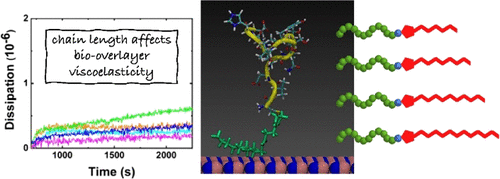当前位置:
X-MOL 学术
›
J. Phys. Chem. B
›
论文详情
Our official English website, www.x-mol.net, welcomes your feedback! (Note: you will need to create a separate account there.)
Controlling the Orientation and Viscoelasticity of Materials-Binding Peptides on Hexagonal Boron Nitride Using Fatty Acids
The Journal of Physical Chemistry B ( IF 3.3 ) Pub Date : 2021-09-10 , DOI: 10.1021/acs.jpcb.1c05446 Nermina Brljak 1 , Marc R Knecht 1, 2 , Tiffany R Walsh 3
The Journal of Physical Chemistry B ( IF 3.3 ) Pub Date : 2021-09-10 , DOI: 10.1021/acs.jpcb.1c05446 Nermina Brljak 1 , Marc R Knecht 1, 2 , Tiffany R Walsh 3
Affiliation

|
The adsorption of materials-binding peptides to technologically relevant 2D nanosheets of h-BN could be transformative for both property modulation and materials applications. To enhance binding, integration of non-natural functionalities into the biomolecule could prove to be important. However, very little is understood regarding the impact of these biomolecular structural alterations on the binding, which could influence the affinity and surface-adsorbed structures. Here, the effect of fatty acid incorporation site and carbon chain length is investigated using the BP7 peptide, previously identified with affinity for h-BN. The peptide was modified at either the N- or C-terminus with a fatty acid chain length of 6–12 carbons long. The binding affinity and bio-overlayer viscoelasticity are quantified using quartz crystal microbalance analysis. While fatty acid conjugation did not substantially affect the affinity of the resultant biomolecules, it did alter the viscoelasticity of the biomolecular overlayer on the h-BN surface based upon the carbon chain length and incorporation site. Molecular dynamics simulations demonstrate interplay between enthalpic and entropic effects in modifying the overlayer viscoelasticity. The simulations predict that C-terminal conjugation promotes the enhancement of upright adsorbed states, compared with the N-terminal case, with this effect most pronounced for the 10-carbon chain.
中文翻译:

使用脂肪酸控制六方氮化硼上材料结合肽的取向和粘弹性
将材料结合肽吸附到技术相关的h -BN 2D 纳米片上对于性能调节和材料应用都可能具有变革性。为了增强结合,将非天然功能整合到生物分子中可能被证明是重要的。然而,关于这些生物分子结构改变对结合的影响知之甚少,这可能影响亲和力和表面吸附结构。在这里,使用 BP7 肽研究了脂肪酸掺入位点和碳链长度的影响,BP7 肽先前已鉴定为对h 的亲和力-BN。该肽在 N 端或 C 端被修饰,脂肪酸链长度为 6-12 个碳。结合亲和力和生物覆盖层粘弹性使用石英晶体微量天平分析进行量化。虽然脂肪酸共轭基本上不影响所得生物分子的亲和力,但它确实根据碳链长度和掺入位点改变了h- BN 表面上生物分子覆盖层的粘弹性。分子动力学模拟证明了在改变覆盖层粘弹性方面的焓和熵效应之间的相互作用。模拟预测,与 N 端情况相比,C 端共轭促进了直立吸附状态的增强,这种效果对于 10 碳链最为明显。
更新日期:2021-09-23
中文翻译:

使用脂肪酸控制六方氮化硼上材料结合肽的取向和粘弹性
将材料结合肽吸附到技术相关的h -BN 2D 纳米片上对于性能调节和材料应用都可能具有变革性。为了增强结合,将非天然功能整合到生物分子中可能被证明是重要的。然而,关于这些生物分子结构改变对结合的影响知之甚少,这可能影响亲和力和表面吸附结构。在这里,使用 BP7 肽研究了脂肪酸掺入位点和碳链长度的影响,BP7 肽先前已鉴定为对h 的亲和力-BN。该肽在 N 端或 C 端被修饰,脂肪酸链长度为 6-12 个碳。结合亲和力和生物覆盖层粘弹性使用石英晶体微量天平分析进行量化。虽然脂肪酸共轭基本上不影响所得生物分子的亲和力,但它确实根据碳链长度和掺入位点改变了h- BN 表面上生物分子覆盖层的粘弹性。分子动力学模拟证明了在改变覆盖层粘弹性方面的焓和熵效应之间的相互作用。模拟预测,与 N 端情况相比,C 端共轭促进了直立吸附状态的增强,这种效果对于 10 碳链最为明显。



























 京公网安备 11010802027423号
京公网安备 11010802027423号